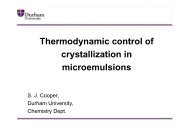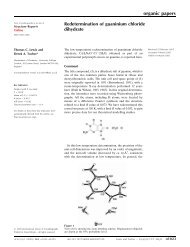An Introduction to the Theory of Crystalline Elemental Solids and ...
An Introduction to the Theory of Crystalline Elemental Solids and ...
An Introduction to the Theory of Crystalline Elemental Solids and ...
Create successful ePaper yourself
Turn your PDF publications into a flip-book with our unique Google optimized e-Paper software.
42<br />
FIG. 21: Upper part: schematic illustration <strong>of</strong> d-b<strong>and</strong> narrowing at transition metal surfaces <strong>and</strong><br />
its consequence for <strong>the</strong> energy levels <strong>of</strong> <strong>the</strong> surface a<strong>to</strong>ms with less than 5 d electrons (N d < 5),<br />
exactly 5 d electrons (N d = 5), <strong>and</strong> more than 5 d electrons (N d > 5). Lower part: PDOS for <strong>the</strong><br />
d orbitals in bulk Zr <strong>and</strong> Ru <strong>and</strong> at <strong>the</strong> surface <strong>of</strong> Zr(0001) <strong>and</strong> Ru(0001), as computed from a<br />
plane-wave pseudopotential DFT calculation within <strong>the</strong> LDA. E d is <strong>the</strong> center <strong>of</strong> gravity <strong>of</strong> <strong>the</strong><br />
d PDOS <strong>and</strong> <strong>the</strong> small arrows indicate that E d is lower at <strong>the</strong> surface than in <strong>the</strong> bulk for Zr<br />
whereas E d is higher at <strong>the</strong> surface than in <strong>the</strong> bulk for Ru (computed by <strong>the</strong> authors).<br />
core hole created by <strong>the</strong> different surroundings <strong>of</strong> <strong>the</strong> core hole at <strong>the</strong> surface <strong>and</strong> in <strong>the</strong><br />
bulk <strong>of</strong> <strong>the</strong> material. The former effect is typically called <strong>the</strong> “initial state” contribution,<br />
whereas <strong>the</strong> latter is called <strong>the</strong> “final” state contribution. The inclusion <strong>of</strong> such “final<br />
state” effects can <strong>of</strong>ten be necessary if quantitative agreement between experimental <strong>and</strong><br />
<strong>the</strong>oretical values <strong>of</strong> SCLS is sought [157–160].<br />
7.3 Surface States<br />
As we have seen <strong>the</strong> electronic structure <strong>of</strong> metal surfaces is likely <strong>to</strong> differ from that<br />
in <strong>the</strong> bulk. One way this altered behavior is exemplified is through <strong>the</strong> formation <strong>of</strong><br />
so-called surface states [161–164]. The surface states <strong>of</strong> metals represent interesting<br />
physical phenomena in <strong>the</strong>ir own right, as examples <strong>of</strong> confined two-dimensional electronic<br />
systems, but can also affect <strong>the</strong> physical <strong>and</strong> chemical properties <strong>of</strong> metallic interfaces,<br />
playing, for example, a role in <strong>the</strong> mediation <strong>of</strong> adsorbate lateral interactions [165–167].<br />
They are routinely observed in experiment, notably with angle-resolved pho<strong>to</strong>emission<br />
spectroscopy (ARPES) or with scanning tunnelling microscopy when <strong>the</strong>y scatter from<br />
surface defects or adsorbates [168, 169].<br />
Consider a wavefunction in <strong>the</strong> bulk as it approaches a metal surface. If it is reflected back<br />
in<strong>to</strong> <strong>the</strong> bulk <strong>and</strong> decays exponentially in<strong>to</strong> <strong>the</strong> vacuum it is a bulk state (Fig. 22(a)).<br />
Certain bulk states may have a larger weight at <strong>the</strong> surface than in <strong>the</strong> bulk. Generally







